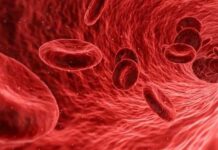According to a new study, an experimental compound reduced complications of type 1 and type 2 diabetes in mice – not by lowering blood sugar – but by countering its consequences: cell death, inflammation, and organ damage.
The new study, which has been published online in Science Translational Medicine, reported that a new class of compounds blocked the ability of a protein called RAGE to pass on inflammatory signals that injure the heart and kidneys in diabetes, and that slow the healing of diabetic wounds.
The results revolve around the body’s immune system, which recognizes and destroys invading bacteria and viruses. This system’s activation causes inflammation, responses like swelling and pain that result from the homing in by immune cells into sites of infection or injury. Many diseases – including diabetes – include misplaced inflammation that damages tissues.
Experiments in human cells and mouse models found that the lead study compound, RAGE229, significantly reduced short- and long-term complications of diabetes.
In particular, high blood sugar generates greater numbers of charged particles that tear apart cell components like DNA. This kills cells, which fall apart and spill their contents, including damage-associated molecular patterns or DAMPS. Such “danger molecules” inform the body that a tissue is under stress, in some cases by activating RAGE, say the authors. When a DAMP docks into RAGE on a cell’s outer surface, it changes the receptor’s shape to pass messages into the cell’s inner compartment, the cytoplasm. Schmidt and colleagues had shown previously that the RAGE cytoplasmic “tail” (ctRAGE) interacts with a protein called DIAPH1 to pass on such messages, which ultimately activate inflammatory genes.
“Our results establish the molecular backbone of RAGE229 as the foundation for a new approach that targets intracellular RAGE actions to counter diabetic tissue damage,” says lead study author Ann Marie Schmidt, MD, the Dr. Iven Young Professor of Endocrinology at NYU Grossman School of Medicine. “With further refinements, RAGE229 and its descendants have great potential to fill gaps in treatment, including that most current drugs work only against type 2 diabetes.”



























